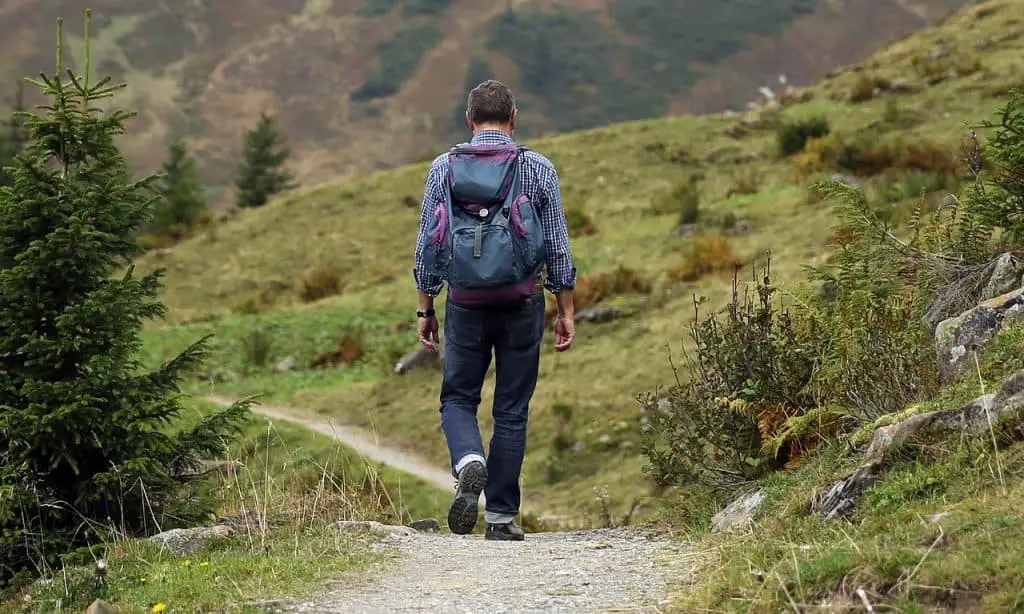When hiking long distances it’s important to make sure we have the right gear for the trip. This usually includes a nice pair of boots that can help protect against rough terrain.
If you bring your dog hiking with you do they need a pair of boots too? Are dog boots necessary? Let’s find out!

There are many factors to consider when deciding whether or not your dog needs boots for hiking.
- How long are you hiking?
- What temperature is it outside?
- What is the environment like where you hike?
- What breed is my dog?
After you’ve answered these questions let’s look at some benefits of dog boots, how important they are, and some pros and cons.
Do Dogs Need Hiking Boots in 2024
Boots are not required but they do help protect your dog’s paws while hiking. Thin boots give your dog a layer of protection against rocks, thorns, and other rough terrains. Dog boots allow their paws to get more traction and support, just as boots do for us.
Benefits Of Hiking Boots For Dogs
Think of all the benefits that you get from wearing hiking boots or shoes.
- Stability
- Traction
- Protection
These same benefits also apply when using booties on a dog.
1. Stability
Stability is an important part of why boots are used. Now you may be thinking your dog needs to help walking and running, but there are times it can help.
The older a dog gets the less stable they will be. They might need some extra support and stability to walk around. It might happen slowly but the extra support from boots can only be a benefit.
2. Traction
Most mountains or trails come with a few different obstacles to overcome. The terrain is one of these obstacles.
The great thing about hiking boots is that they add a huge amount of traction while hiking. Hiking shoes and boots add better traction against the following,
- Snow
- Ice
- Water
- Rocks
- Hot pavement
- Uneven ground
So if you are often around sharp rocks, uneven terrain, or any icy path, you can’t get any better support than boots.
3. Protection
Dogs that spend most of the time inside have much softer pads than those that are outside a lot more. These pads can toughen over time just from walking on rougher ground.
Softer paws aren’t a problem, but they can lead to more injuries in your pup. The extra padding of a boot offers protection against hot rocks, uneven ground, thorns, and bushes.
The good news is that even a cheap pair of boots can help prevent scrapes from hiking and cracked foot pads.
Negatives Of Hiking Boots For Dogs
A dog’s paws are much tougher than you would think, but they still need some protection. We just went over the benefits that boots can provide, let’s talk about some of the negatives.
1. Dogs Hate Wearing Boots
This is an easy realization to make. You probably won’t find many dogs that enjoy wearing boots, at least right from the start.
It takes time and patience, but eventually, your dog will accept wearing boots. On top of that, you’ll feel more comfortable about their safety and protection against injuries!
2. Takes Time To Adjust To Boots
Dog’s that have never had anything on their paws will have some struggles adjusting to boots. The process of adapting to having anything on their paws will take some time.
You should have a routine of using the boots for at least an hour a day for the first week. This amount of time keeps the progress moving forward without overwhelming your dog with the change.
3. Finding The Right Size For Your Dog
The first step to getting boots for your dog is to measure and figure out sizes. Just like boots for us, they need to be snug and not loose in order to work. There are some standard sizes that are used for these boots.
- Tiny
- XX-Small
- X-Small
- Small
- Medium
- Large
- X-Large
You can use this size chart guide if you want to measure your dog’s paws for boots.
4. Paws Can’t Toughen Up
Over time the paw’s on a dog will form calluses and toughen from rougher exposure. It’s important that this process doesn’t happen too quickly or it could lead to injury.
Boots will slow down this process or stop it completely.
How do I protect my dog’s paws when hiking?
We’ve gone over wearing boots to protect a dog’s paws, are there any alternatives to protect your dog’s paws when hiking?
There are a few tips that we’ve found over the years to help with normal wear and tear from hiking with your dog.
1. Avoid Hiking When It’s Too Hot Out
A dog’s paws are tough and can withstand most temperatures that we see. Those days that reach high temperatures make it more likely to see injuries in your dog.
Keep track of what temperature you feel comfortable going hiking and take it easy and slow if you feel it’s too hot.
2. Check Paws After Each Hike
We suggest checking the paws after each hike. It really only takes a few seconds and is an easy way to make sure nothing is wrong. A quick check will alert you to any cracks or scratches that could happen while hiking.
And if you do notice something, now you can start the recovery process and let those paws heal up!
3. Allow Paws To Toughen Up
The best way to keep your dog injury-free is to have a mix of what their paws are exposed to. The pavement and rough ground are important to help build up resistance to those tough terrains they may experience during a hike. This increased resistance will directly help decrease injury chances while hiking. Even though we can wear hiking shoes every day, you should limit how often your dog does.
4. Use Paw Wax
Paw wax lotion is one alternative option to using boots on your dog. The layer of protection works similar to boots and is great against sand, hot pavement, salt, or ice.
If you’ve notices any small injuries while hiking this wax is also great to increase healing for cracked and slightly damaged paws.
Do Dogs Need Hiking Boots In The Winter?
Hiking boots aren’t only made for warmer temperatures. The protection they provide continues into the winter.
The salt that is used during the winter can be very rough to walk on, and snow and ice mean less traction.
To be as safe as possible you can continue using boots in the winter for more support.
How Much Do Dog Boots Cost?
There are too many questions to determine the average cost for dog boots.
- Are they waterproof?
- What size boots do you need?
- How often will the boots be used?
However, a quick search lets us know, the cost of dog boots ranges from $15 for lower quality to $75 for higher quality.
Final Thoughts
After looking at the benefits that boots provide while hiking we recommend trying to find a pair for your pup. It takes a few trips for them to get used to the feeling, so don’t give up after one try.
If you’re trekking over sharp ground and rocks then dogs need hiking boots. However, if you’ve decided that the boots aren’t necessary you could always keep a pair for backup. The last thing you want it to be halfway into a long hiking trip and have your dog cut or scrape their paws.
Having a pair of boots handy will make the return trip more comfortable and safe for your dog.






